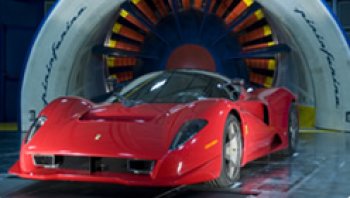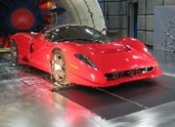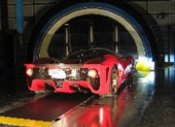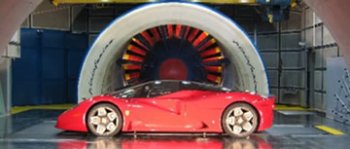|
With a four
million euros investment Pininfarina is ready to enter the
racing world and widen the range of services offered to the
customer. It is called
'T-Belt' and it uses
three belts in combination. It is
the new Ground Effect Simulation System,
installed in the full-scale Automotive Wind
Tunnel at the Pininfarina
Aerodynamic Centre in
Grugliasco, Turin,
which was inaugurated recently in the presence of the Chairman
and CEO Pininfarina Group, Andrea Pininfarina,
of the Director Aerodynamic and Aeroacoustic Research Centre
Pininfarina, Antonello Cogotti, of
the Regional Councillor for Innovation,
Andrea
Bairati, and Major of Grugliasco,
Marcello Mazzù.
The new
technology required a four million euros investment
and it replaces the single-belt system installed in 1995,
which was the first in the world to be able to test
full-scale cars by simulating the aerodynamic effects due to
wheel rotation and ground relative motion. “Pininfarina continually invests in research
and innovation programmes in all the areas of activity it
covers – comments Andrea
Pininfarina. –In the case of the Aerodynamic and
Aeroacoustic Research Centre, innovation allows us to face
new business opportunities in sectors never explored before,
such as the racing
one."
This further investment is part of the
strategy followed by Pininfarina Group to
extend the range of services offered
to the car makers: the Wind Tunnel, in fact, created in 1972
and remained for a long time the sole in Italy and one of
the few in the world. It is used not only for the
aerodynamic and aeroacoustic tests for cars manufactured in
Pininfarina’s facilities, but also for external customers
who do not possess technologies so sophisticated and
updated. Therefore, the Wind Tunnel in Grugliasco, together
with Test Track CERAM (Centre
d’Essais et de Recherche Automobile de Mortefontaine, Paris)
the Special Projects Division and
the activities of product and interior design made by
Pininfarina Extra, complete the range of
services starting from Design arriving to the Product and
Process Engineering and Niche Vehicles Manufacturing making
Pininfarina Group a full
service provider.
Pininfarina has
shown itself over a number of years now to be a real
industrial strength to be reckoned with. This is well and
truly backed up by the five new production lines set up
between the end of 2005 and 2006: the Alfa Romeo Spider,
Mitsubishi Colt CZC and Ford Focus Coupé-Cabriolet – where
we also dealt with the design and development, and the Volvo
C70 and Alfa Romeo Brera - where we were also in charge of
the engineering.
“During 2006 we have set up five new
production lines – adds Andrea Pininfarina – with an
economic and industrial effort unprecedented in the history
of the Company. We are relieved by the number of orders that
make us predict a sales success for all the models we are
manufacturing: Alfa Romeo
Spider, Alfa Romeo Brera, Mitsubishi Colt CZC, Volvo C70 and
Ford Focus Coupé-Cabriolet. The strong
engagement dedicated to the manufacturing activities did not
divert our energies from the design and engineering sectors,
as showed by the investments in research and technology, the
success of the Special Projects Division end the
reorganization of our presence in
Germany.
Among the main
characteristics of the new system – protected by a patent -
the overall width of the upstream end of the moving ground
has been increased from 1.0 m to 2.5 m, for a length of 1.5
m, by the installation of 3 belts side by side. The central
belt is 6.7 m long and the two side belts are 1.5 m long,
extending from the front of the central belt to the front
wheels. “In particular – explains
Antonello Cogotti - the
large width of the moving ground front end is important for
front-wing and front-diffuser equipped
racing
cars, as well as for conventional cars with wheel
housings. The improved
simulation of the flow upstream of the front wheels improves
the flow around the wheels and within the wheel-housings,
and will lead to a better flow under the vehicle. It is
known that the front wheels and their wheel housing are the
most important source of a car aerodynamic drag and their
behaviour will now be better simulated. Furthermore it
improves the simulation for front brake flows and
radiator/cooling-package flows."
|

 
 |
|
Among the main characteristics of the new system –
protected by a patent - the overall width of the
upstream end of the moving ground has been increased
from 1.0 m to 2.5 m, for a length of 1.5 m, by the
installation of 3 belts side by side. |
|
|
 |
|
With a four
million euros investment Pininfarina is ready to enter the
racing world and widen the range of services offered to the
customer. |
|
|
The
maximum
velocity of the three belts has been increased
to 250 km/h (it was 200
km/k in the old
system), to reach the same maximum speed as the wind,
increased itself to 250 km/h since 2005 through the
installation of a 13 fans system.
Ground Effect
Simulation System "G.E.S.S."
A new Ground Effect Simulation System (GESS),
called the “T-Belt” and using three belts in
combination, has been in operation since
September 1st 2006 in the full-scale
Automotive Wind Tunnel of the Pininfarina
Aerodynamic Center.
It replaces the single-belt system installed
in 1995 , which was the first in the world
to be able to test full-scale cars by
simulating the aerodynamic effects due to
wheel rotation and ground relative motion.
The new system substantially improves the
simulation of the ground effect and provides
a further important technical advantage
compared to our competitors.
This system, which is patented to protect
the unique geometric layout (three belts in
a T-Shape) as well as the driving details of
the three belts, is shown in the
photographs.
well as the driving details of the three
belts, is shown in the photographs. The main
characteristics of the new system are: The overall
width of the upstream end of the moving ground has been
increased from 1.0 m to 2.5 m, for a length of 1.5 m, by
the installation of 3 belts side by side. The central
belt is 6.7 m long and the two side belts are 1.5 m
long, extending from the front of the central belt to
the front wheels. This layout
provides an excellent simulation of the ground effect
under the car front end, for both passenger and racing
cars, and is a major improvement compared to the single
narrow belt. The car front-end flow is critical, as the
approaching flow is a ‘high energy’ flow, not yet
spoiled by the rotating front wheels.
In
particular: The large
width of the moving ground front end is important for
front-wing and front-diffuser equipped racing cars, as
well as for conventional cars with wheel housings. The
improved simulation of the flow upstream of the front
wheels improves the flow around the wheels and within
the wheel-housings, and will lead to a better flow under
the vehicle. It is known that the front wheels and their
wheel housing are the most important source of a car
aerodynamic drag and their behaviour will now be better
simulated. Furthermore it improves the simulation for: Front brake flows
and Radiator/cooling-package flows; The longer,
6.7 m central belt provides a good simulation of road
motion even for very long cars, having about 1 m of
moving ground ahead of the car and 1 m downstream of the
car and its wake. It may also be used to test other long
scale models such as trains or trucks, where length is
the major dimension. The model scale can be increased,
improving model detail, and therefore, measurement
accuracy.
The maximum velocity of the three
belts has been increased to 250 km/h (it was 200 km/h in the
old system), to reach the same maximum speed as the wind. This increased test
speed is necessary to uncover the aero-acoustic sources
that appear at high speed only and are caused by the
deformation of body parts. It may be also important for
the measurement of the deformation of some add-on
aerodynamic parts of racing cars. The four
rollers that provide wheel rotation have increased
diameter. Now, cars can be tested without removing the
suspension springs because the rollers can support the
full weight of the car. The supports of the rockers
restrain the car from any horizontal motion while the
vertical motion is free.
Possibility
in the future of measuring Lift and Aerodynamic Torque
for each of the four wheels through sensors installed on
each wheel drive unit. This information may be of
interest mainly in the case of racing cars. The presence of an upstream car,
(racing or passenger), with its down-lifting or
up-lifting vortices can be easily simulated with the
TGS (Turbulence Generation System) and that further
improves the simulation of the road condition. The car
standing heights are remotely controlled by computer
through 4 supports acting on the car rockers.
Any combination of pitch, roll (and yaw, by turning the
turn-table) can be achieved in continuous without
stopping the wind. This is very important to speed up the
tests. In order to
be able to modify the car underbody, the car can be
lifted in less then 30''. All these improvements may bring new optimal aerodynamic
solutions different from the existing ones and will
provide an improved on-track and on-road simulation in
the wind tunnel.
|
|
|
|